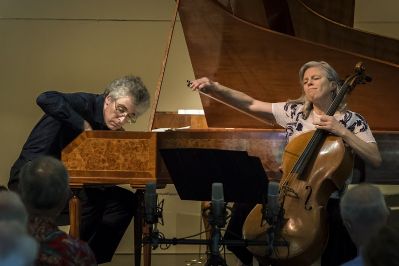|
Symphony
SRS SEASON ENDS WITH RESOUNDING TA-TA-TA-BANG
by Terry McNeill
Sunday, June 1, 2025
Symphony
YOUTHFUL VIRTUOSITY ON DISPLAY AT USO'S MAY CONCERTS
by Peter Lert
Saturday, May 17, 2025
Symphony
MYSTICAL PLANETS AND LIVELY GERSHWIN ORTIZ AT FINAL SRS CONCERT
by Peter Lert
Sunday, May 4, 2025
Symphony
VSO'S CONCERT MUSIC OF TIME, MUSIC OF PLACE
by Peter Lert
Sunday, April 27, 2025
Choral and Vocal
VOCAL ELEGANCE AND FIRE AT THE 222'S RECITAL APRIL 26
by Pamela Hicks Gailey
Saturday, April 26, 2025
CANTIAMO SONOMA SINGS AN INSPIRED GOOD FRIDAY MOZART REQUIEM CONCERT
by Pamela Hicks Gailey
Friday, April 18, 2025
DRAMATIC SHOSTAKOVICH SYMPHONY CLOSES PHILHARMONIC'S 25TH SEASON
by Terry McNeill
Sunday, April 13, 2025
LARGE COLLEGE OF MARIN AUDIENCE GREETS STOPHER ARTISTRY
by Terry McNeill
Saturday, April 5, 2025
Chamber
FRISSON DELIVERS SHIVERS OF DELIGHT
by Abby Wasserman
Sunday, March 30, 2025
OLD AND MOSTLY NEW IN SRS MARCH CONCERT IN WEILL
by Peter Lert
Saturday, March 22, 2025
|
 |
 Eric Vivian and Tanya Tomkins Play Beethoven July 17 (John Hefti Photo) |
PERIOD INSTRUMENT SOUND AT VOM FESTIVAL'S OPENING CONCERT AT HANNA CENTER
by Terry McNeill
Sunday, July 17, 2016
Every summer music festival has a unique character, and the Valley of the Moon Music Festival in Sonoma has the singular character of stressing period instruments that sound well for mostly period repertoire.
In the Festival’s opening concert July 17 this was best in evidence for two Beethoven works, the “Kakadu” Piano Trio and the seven cello variations based on a theme from Mozart’s opera “The Magic Flute.” Eric Zivian, Northern California’s premier fortepianist, brought two of his instruments (period copies) to the Hanna Boys Center auditorium and convinced even skeptical listeners of the fortepiano’s center stage role.
He began with a movement of Clementi’s B Flat Sonata, Op. 24, No. 2, with fluid scale playing and balance in the registers. Key dip in a c. 1795 instrument is less than a modern piano, allowing for rapid rippling scales, clipped phrasing and assured ornamentation. The cadenza was short.
Mr. Zivian, heard in every work on the program, then joined tenor Kyle Stegall in a brief aria from Mozart’s Opera “Magic Flute.” Titled Die Bildnis ist Bezaubernd, the music brought out Mr. Stegall’s rich sonority, excellent German diction and his skill at swelling delicately on soft notes. It was charm with strength.
Gut strings are a required item for most Festival music at Hanna, and the Mozart Major Sonata for Violin, K. 526, was played with these strings by Elizabeth Blumenstock, again with Mr. Zivian at the piano. In the Molto Allegro the violinist’s tone was thin and often covered by the piano, with ends of phrases fading away and little rhythmic flexibility. It went this way through the Sonata, though in the Andante the duo played lovely balanced pianissimo phrases.
This reviewer has heard the violinist many times before, mostly with the renowned American Bach Soloists, and in music with less required vibrato and projection the result has been impressive. This afternoon, even during the Presto finale, the violin articulation didn’t save a timid sound. This reaction may simply be too deep an association with classical recordings of the A Major with more powerful steel strings, from Grumiaux/Haskill and Schumsky/Balsam.
After intermission Festival founder and cellist Tanya Tomkins joined Mr. Zivian for the buoyant Variations on Bei Männern, welche Liebe Fühlen.” Here Ms. Tomkins' instrument also had gut strings but had a strong bottom end sound and that was agile but different from a differently strung cello. The phrasing throughout was deft and Mr. Zivian, in a long introduction to the fourth Variation, inserted brief tasty ritards, meshing well with Ms. Tomkins’ slow vibrato at the end of phrases. Mozart’s catchy tune with this duo became a cheerful delight.
Mr. Stegall returned to sing three Mozart Lieder. The short (45 seconds) Wie unglücklich bin nit (K. 125g) found him almost in a baritone range, and the Lied der Freiheit (K. 506) was bouncy and animated, with crystal clear diction. Song three was certainly the highlight, and the warm Abendempfindung (K. 523) had a questioning plea over soft arpeggios from Mr. Zivian, and ascending and descending soft scales from Mr. Stegall. It was the longest song and caught a plaintive and sad character. Applause was heavy.
Ending the concert was the G Minor Beethoven Trio, Op. 121a, with Mr. Zivian using a Mendelssohn-era piano. Following a long somber introduction the music is light hearted, and the trio played it that way. Ms. Blumenstock at times used a Spiccato bow in variations with clipped phrases and each variation seemed to ease naturally into then next one.
Thematic projection qualities from the violin and cello fit the 1824 work perfectly, though the top notes in the piano had a peculiar electric piano tone quality without partials. The composer’s phenomenal command of the variation form was everywhere in evidence, and the Accelerando to the end brought the concert to a vivid close.
There was no encore and refreshments were served on the auditorium’s breezy and sunny deck, a happy VOM tradition set to carry through the additional seven concerts of the second year of the Festival.
|

